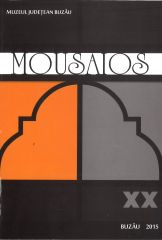Despre un complex din a doua epocă a fierului descoperit la Şoimuş (jud. Hunedoara)
About a Second Iron Age Complex Discovered at Şoimuş (Hunedoara county)
Author(s): Cristina Bodó, Ioana Lucia Barbu, Marius BarbuSubject(s): Archaeology
Published by: Muzeul Judetean Buzău
Keywords: Second Iron Age; Şoimuş; pits; dog; animal deposits
Summary/Abstract: The rescue archaeological research on the route of “The Bypass Deva - Orăștie motorway standard, Hunedoara County” brought new information about the habitation on the Mureș Valley, filling the archaeological map of the area. The site from Șoimuș - Lângă Sat, situated on the first terrace of the Mureș River, on the right bank of the river, was also unearthed among the others. They were discovered traces of habitation from the Copper Age (Tiszapolgár culture), Coțofeni culture, Bronze Age, the First Iron Age, the Second Iron Age, the Migration Period, the Middle Ages, 634 features being investigated. Regarding the findings from the Second Iron Age, 19 features were identified in the excavated surface, the investigated area being probably only one side of the housing in the questioned period. Most of the inventory consisted of handmade (the majority) and wheel-made pottery. The common forms are fruit bowls, jars, bowls, cups etc. Besides pottery, bone remains were also found; we must mention that there have not been found any metal objects. Among the investigated complexes, we present in detail a pit (Complex 13) of 1.60m in diameter and 0.60m in depth, with a skeleton of a dog discovered in. It was deposited in the western part of the pit, the top of the skeleton appeared at -0.20 to -0.25 m in depth from the contouring of the pit (not at the bottom). The dog was kept almost entirely, with the bones in anatomical order, lying on the right side, the head to the South, with the body slightly arched and the posterior legs stretched. The front legs were not kept. Unfortunately, the conditions of the discovery have not allowed more detailed and careful observations, and the bones were extremely friable and destroyed due to soil quality. The ceramic fragments were discovered into the filling of the pit, without noticing any particular order. They come from vessels dated in the classical period of the Dacian civilization. There are fragments of fruit bowls and jar vessels. This feature is adding to the dog deposit pits from the Dacian-Getic environment (not very many), the meaning of the holes being interpreted differently, in connection with the area of the settlement where they were placed: the results of sacrifice and ritual burial, for example – those from housing or ditches, or deposits with sentimental character – those from the settlement. For the discovery from Şoimuş, in the current state of research, we can say that in a pit already partially filled, the body of a dog was deposited, entire, along with some of his food (cattle long bone), then the pit was filled relatively quickly. Taking into consideration the fact that the discovery was made at the edge of the settlement from the Second Iron Age, this action may have had a sentimental character (burying your pet carefully) or can be connected with the role of the guardian dog (thus, defending the settlement).
Journal: Mousaios
- Issue Year: 2015
- Issue No: 20
- Page Range: 111-122
- Page Count: 12
- Language: Romanian

